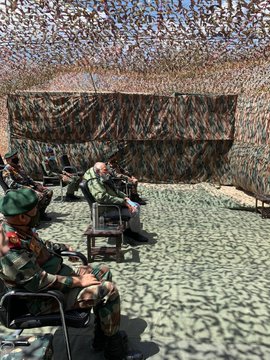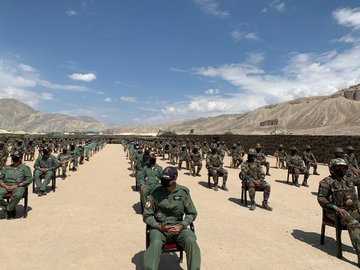
New Delhi: Prime Minister Narendra Modi Friday lashed out at China, saying the “age of expansionism is over” and that New Delhi will continue to develop infrastructure in the border areas.
Addressing the Army, ITBP and Air Force personnel in Ladakh, PM Modi lauded their efforts and dedication in protecting their “motherland” and said the “fire and fury” of the armed forces have made him proud.
Without naming China, the prime minister contrasted the policy of expansionism and developmental growth. “The age of expansionism is over. The world has moved on the path of development. Expansionist forces have ruined the world in the last century. They have either been defeated or forgotten in history… History is witness that expansionist forces have either lost or were forced to turn back,” he said.
The PM’s visit to Ladakh has, however, angered China, which saw it as an attempt to “escalate” tensions.
Chinese Foreign Ministry spokesperson Zhao Lijian said, “India and China are in communication and negotiations on lowering the temperatures through military and diplomatic channels.
“No party should engage in any action that may escalate the situation at this point,” he said.
Ji Rong, spokesperson, Embassy of China in India, meanwhile, tweeted: “China has demarcated boundary with 12 of its 14 neighboring countries through peaceful negotiations, turning land borders into bonds of friendly cooperation. It’s groundless to view China as ‘expansionist’, exaggerate & fabricate its disputes with neighbours.”
Experts, however, said Modi’s visit was “a powerful image and a powerful message”, and a sign that the Indian government is not going to let China either escalate the crisis or gloss it over.
Also read: India’s options against China shrink to two — limited war or another Wuhan
‘This land in Ladakh is India’s crown’
While paying tributes to the soldiers who were killed in the violent face-off in Galwan, Modi compared the willpower of the soldiers with that of the mountains they’re surrounded with.
“Every Indian’s head bows before its brave saviours. This land boasts of several stories of bravery and gallantry of Indian jawans,” said Modi, who was accompanied by Army Chief General M.M. Naravane and Chief of Defence Staff Bipin Rawat.
“The bravery of 14 Corps will be talked about everywhere. Our enemies have seen your fire and fury. This land in Ladakh is India’s crown. It has given several brave hearts to the nation… The resolve of a self-reliant India becomes stronger because of your sacrifices,” he said.
The prime minister said Indian soldiers had a long history of bravery and competence in global military campaigns, including in the two World Wars.
“Whenever I think of a decision based on national security, I think of two mothers. The first is our Mother India. The second is our mothers who’ve given birth to brave hearts such as you,” he said, addressing the soldiers.
PM Modi also visited the military hospital in Leh where he met those injured in the face-off in Galwan.
In his interaction with the soldiers at the hospital, Modi said, “Our country has never bowed down and will never bow down to any world power, and I am able to say this because of the braves like you.
“The braves who left us, they didn’t depart without reason, all of you gave a befitting reply.”
Modi added that the bravery displayed by them will inspire coming generations and the country as a whole. “A message has gone to the world about the valour shown by you braves. The way you stood up to the powers, the world wishes to know who are these braves? What is their training? What is their sacrifice? World is analysing your bravery,” he said.
Modi said he pays his respects to not only them, but to their mothers as well.
The prime minister said he had come to just meet them, and is taking back with him fresh energy.
The PM also said: “We are the same people, who pray to the flute-playing Lord Krishna, but we are also the people who idolise and follow the same Lord Krishna who carries the ‘Sudarshana Chakra’.
“Peace can never be brought by the weak. Power is the condition to bring peace. India is widening its powers on land, air and water and this is for the welfare of mankind,” he added.
Also read: Modi govt and military leaders have soldiers’ blood on hands. PM’s dilemma now same as Nehru
PM’s visit a morale boost: Amit Shah, Rajnath
The PM is now on his way to Delhi where he is expected to hold a meeting with Defence Minister Rajnath Singh, External Affairs Minister S. Jaishankar, Home Minister Amit Shah and National Security Advisor Ajit Doval, according to sources.
Shah, meanwhile, tweeted, saying PM’s visit will “surely boost the morale of our valorous soldiers”.
“Leading from the front. Prime Minister Shri @NarendraModi Ji with our brave and courageous personnel of Army, Air Force & ITBP at a forward location in Ladakh. This visit of honourable PM will surely boost the morale of our valorous soldiers. #ModiInLeh,” he wrote.
Rajnath Singh echoed similar sentiments and said the border areas between India and China in the Ladakh sector have always been kept secure by the Indian Army.
“The borders of the country have always been secure under the Indian Army. Prime Minister Shri @narendramodi going to Ladakh today and meeting the army soldiers and encouraging them has certainly boosted the morale of the army and I thank the Prime Minister for this move,” Singh tweeted.
‘Loud and clear message to China’
Experts believe Modi’s visit coupled with his speech was much-needed amid the stand-off that began in early May.
“This was a powerful image and a powerful message. The Indian PM’s visit is a sign that the Indian government is taking this situation very seriously and is not going to let China either escalate the crisis or gloss it over,” said Rory Medcalf, head of the Australian National University’s National Security College.
“Indeed, the message is quite awkward for China. It shows self-confidence and staying power on the part of India, while also making it hard for Beijing to downplay what has happened,” said Medcalf.
Medcalf, the author of Contest for the Indo-Pacific: Why China Won’t Map the Future, also likened Modi’s pushback on expansionism as that of “India’s triumph over the British empire and the role of Indian forces in stopping imperial Japan”.
“It’s a strong rallying cry for Indian national identity and the sovereignty of partner nations,” he said.
He added that Modi’s message about development was important. “It shows that India is playing a long game. India is gradually strengthening itself, building security partnerships and holding the line. The recipe to manage and limit Chinese power has five ingredients — deterrence, diplomacy, development, solidarity and resilience — and we are seeing them all.”
Jayadeva Ranade, president of Centre for China Analysis and Strategy, said the prime minister’s message was a “rallying cry to the troops” and the situation continues to remain serious.
“It was a clear message to China. It also gave the message loud and clear to China that Galwan Valley belongs to India. He very clearly said that India is a peace-loving country, but it will not shy away if there is a confrontation.”
The PM’s visit was also seen as a strong message to the opposition, especially the Congress, who have been questioning the government’s handling of the border crisis over the past few weeks.
(With inputs from Snehesh Alex Philip)
Also read: China believes India wants Aksai Chin back. PLA has likely secured 40-60 sq km in Ladakh









































































